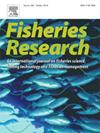A mathematical proof comparing the statistical properties between two common approaches for parameterizing sex-composition likelihoods in fishery stock assessments
IF 2.2
2区 农林科学
Q2 FISHERIES
引用次数: 0
Abstract
Two primary methods for parameterizing sex-specific age and length composition likelihoods in fishery stock assessments exist, which we refer to as the ‘Joint and ‘Split’ approaches. When using the ‘Joint’ approach, sex-composition data are assumed to arise from a single statistical model that describes the probability of sampling across all ages and sexes in a given year. By contrast, the ‘Split’ approach assumes that sex-composition data arises from several statistical models: sex-specific models that describe the probability of sampling ages within each sex, and an additional model that describes the sex-ratio information from composition data. In this mathematical proof, we derive the statistical properties of both approaches under multinomial and Dirichlet-multinomial sampling and show that they produce equivalent model expectations. However, we illustrate that the ‘Split’ approach leads to smaller assumed variances when sampling follows a Dirichlet-multinomial distribution, because overdispersion acts independently within each sex rather than jointly across sexes. Given that both approaches yield equivalent model expectations, we generally recommend using the ‘Joint’ approach for parameterizing sex-composition likelihoods. The ‘Joint’ approach is simpler to implement, aligns with most fisheries sampling designs, and is able to jointly account for overdispersion and sampling correlations across sexes. However, we acknowledge that in some cases, the ‘Split’ approach may be more appropriate.
求助全文
约1分钟内获得全文
求助全文
来源期刊

Fisheries Research
农林科学-渔业
CiteScore
4.50
自引率
16.70%
发文量
294
审稿时长
15 weeks
期刊介绍:
This journal provides an international forum for the publication of papers in the areas of fisheries science, fishing technology, fisheries management and relevant socio-economics. The scope covers fisheries in salt, brackish and freshwater systems, and all aspects of associated ecology, environmental aspects of fisheries, and economics. Both theoretical and practical papers are acceptable, including laboratory and field experimental studies relevant to fisheries. Papers on the conservation of exploitable living resources are welcome. Review and Viewpoint articles are also published. As the specified areas inevitably impinge on and interrelate with each other, the approach of the journal is multidisciplinary, and authors are encouraged to emphasise the relevance of their own work to that of other disciplines. The journal is intended for fisheries scientists, biological oceanographers, gear technologists, economists, managers, administrators, policy makers and legislators.
 求助内容:
求助内容: 应助结果提醒方式:
应助结果提醒方式:


